Everyday Mathematics 2nd Grade Answer Key Unit 8 Geometry and Arrays
Everyday Math Grade 2 Home Link 8.1 Answer Key
Shapes
Family Note
In this lesson children examined different shapes, such as triangles, quadrilaterals, pentagons, and hexagons. They also discussed these shapes’ attributes—or characteristics—such as the number of sides, the number of angles, whether the sides are parallel, and whether the angles are right angles.
Look at the various shapes shown below. Examples of these shapes can be found in objects you see every day, such as yield signs (which resemble triangles) or TV screens (quadrilaterals). As your child cuts out pictures of shapes, discuss each one. Count the number of sides and angles and try to name the shapes. Talk about how they are alike and how they are different.
Please return this Home Link to school tomorrow or as requested by the teacher.
Question 1.
Cut out pictures from newspapers and magazines that show 3-sided, 4-sided, 5-sided, and 6-sided shapes. Ask an adult for permission first.
Answer:

Explanation:
In the above image we can observe 3-sided, 4-sided, 5-sided and 6-sided shapes. A triangle is a polygon with three edges and three vertices. It is one of the basic shapes in geometry. In geometry, a square is a regular quadrilateral, which means that it has four equal sides and four equal angles. In geometry, a pentagon is any five-sided polygon. In geometry, a hexagon is a six-sided polygon or 6-gon.
Question 2.
Glue or tape each picture to a sheet of paper.
Answer:
Question 3.
Label some of the pictures with their shape names.
Answer:

Explanation:
In the above image we can observe different types of polygons there are Square, Hexagon and Rhombus.
In geometry, a square is a regular quadrilateral, which means that it has four equal sides and four equal angles.
In geometry, a hexagon is a six-sided polygon or 6-gon.
Rhombus is a quadrilateral all four sides have the same length. Another name for Rhombus is equilateral quadrilateral.
Question 4.
Bring your pictures to school.
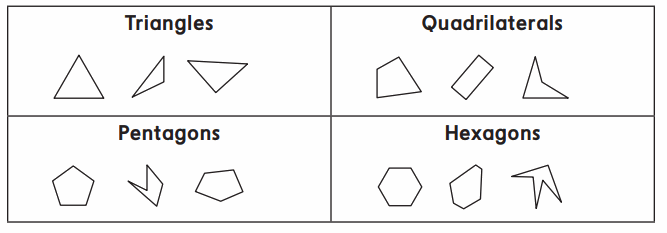
Practice
Add.
Question 5.
24 + 12 = __
Answer:
24 + 12 = 36
Explanation:
An addition sentence is a mathematical expression that shows two or more values added together. In the above expression we can observe two numbers 24 and 12. First add four and two in one’s place right side then we got six. Keep six in one’s place and then add two and one in ten’s place, left side then we got three write three in ten’s place. By adding these two numbers 24 and 12 we got 36.
Question 6.
33 + 19 = __
Answer:
33 + 19 = 52
Explanation:
An addition sentence is a mathematical expression that shows two or more values added together. In the above expression we can observe two numbers 33 and 19. First add three and nine in one’s place right side then we got twelve. Keep two in one’s place and then add one to three and one in ten’s place, left side then we got five write five in ten’s place. By adding these two numbers 33 and 19 we got 52.
Question 7.
47 + 36 = ___
Answer:
47 + 36 = 83
Explanation:
An addition sentence is a mathematical expression that shows two or more values added together. In the above expression we can observe two numbers 47 and 36. First add seven and six in one’s place right side then we got thirteen. Keep three in one’s place and then add one to four and three in ten’s place, left side then we got eight write eight in ten’s place. By adding these two numbers 47 and 36 we got 83.
Everyday Math Grade 2 Home Link 8.2 Answer Key
Attributes of Shapes
Family Note
In this lesson children played a game called Shape Capture, in which they “captured” shapes based on attributes: the number of sides, the number of angles and vertices, the number of right angles, the number of pairs of parallel sides, and side lengths. After your child has completed the Home Link, discuss how the shapes he or she circled are different from the others.
Please return this Home Link to school tomorrow.
Question 1.
Look at the number of right angles. Circle the shape(s) with 1 right angle.

Answer:

Explanation:
In the above image we can observe different types of shapes. we have to find out the number of right angels and then we have to draw a circle for 1 right angle. An angle whose measure is exactly 90° is called as right angel. In the above image first polygon having one right angel. Draw a circle for first polygon.
Question 2.
Look at the number of sides and angles. Circle the shape(s) with 5 sides and 5 angles and 5 vertices.

Answer:

Explanation:
In the above image we can observe four different types of shapes. we have to find out the number of sides and angles and then we have to draw a circle for 5 sides and 5 angels and 5 vertices. A polygon with 5 sides and 5 vertices is known as pentagon polygon. First three polygons having 5 sides and 5 angels and 5 vertices. So draw a circle for first three polygons.
Question 3.
Look at the lengths of the sides. Circle the quadrilateral(s) with 2 pairs of equal-length sides.

Answer:

Explanation:
In the above image we can observe four different types of shapes. We have to find out the lengths of the sides and then we have to draw a circle for the quadrilaterals with 2 pairs of equal length sides. In the above four quadrilaterals having 2 pairs of equal-length sides. So draw a circle for all the four polygons.
Question 4.
Look at the opposite sides. Circle the quadrilateral(s) with one or more pairs of parallel sides.

Answer:

Explanation:
In the above image we can observe four different types of shapes. we have to find out the opposite sides and then we have to draw a circle for the quadrilaterals with one or more pairs of parallel sides. In the above first three quadrilaterals having one or more pairs of parallel sides. So draw a circle for first three quadrilaterals.
Everyday Math Grade 2 Home Link 8.3 Answer Key
Shapes Museum
Family Note
In today’s lesson children used straws and twist ties to build polygons and then drew the shapes. Children learned that polygons are closed figures made up of all straight sides that do no cross.

Please return the top part of this Home Link to school tomorrow.
For Problems 1–3, draw the polygon and write its name on the line.
Question 1.
6-sided polygon:
Answer:
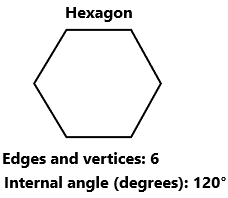
Explanation:
In geometry, a hexagon is a six-sided polygon or 6-gon. The total of the internal angles of any simple hexagon is 720°. A polygon is an enclosed figure with straight lines that do not cross over one another. Polygons do not necessarily have equal sides. A convex polygon has all angles pointing outward, but in a concave polygon, some angles can point inward.
Question 2.
5-sided polygon:
Answer:
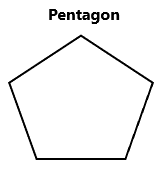
Explanation:
A pentagon is a five-sided polygon. A regular pentagon has 5 equal edges and 5 equal angles. In a five-sided polygon, all sides are equal and all angles are also equal, then it is called a regular pentagon. When this is not the case, it is called an irregular pentagon. For regular pentagons, all internal angles are equal to 108 and all external angles equal 72 degrees. The sum of the five internal angles is 540 degrees.
Question 3.
4-sided polygon:
Answer:
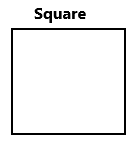
Explanation:
In geometry, a square is a regular quadrilateral, which means that it has four equal sides and four equal angles (90-degree angles, or 100-gradian angles or right angles). It can also be defined as a rectangle in which two adjacent sides have equal length.
Question 4.
Are these three shapes all polygons? Explain.
Answer:
Yes all the above three shapes are polygons.
Explanation:
Yes, all the above three shapes are polygons. A plane figure with at least three straight sides and angles is called a polygon and so all the above given shapes have four or more sides and they are closed figures made up of all straight sides that do no cross. Hence, we can consider all the shapes as polygons.
Shapes Museum
For the next few days our class will collect items to put into a Shapes Museum. Starting tomorrow, bring items such as boxes, soup cans,
party hats, pyramids, and balls to school. Ask an adult for permission to bring in the se item s.
Answer:
Everyday Math Grade 2 Home Link 8.4 Answer Key
Drawing Shapes
Family Note
In this lesson your child learned about attributes of quadrilaterals (four-sided figures). We drew quadrilaterals with certain numbers of right angles and wrote about how we knew the shape had the correct attributes. We will revisit how to recognize and draw quadrilaterals and other shapes for the rest of the school year.
Please return this Home Link to school tomorrow.
Question 1.
Draw a quadrilateral that has four right angles. Use the dots to help you.

Answer:
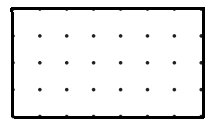
The above quadrilateral has four right angels. The shape of the above quadrilateral name is rectangle.
Explanation:
In geometry, a rectangle is a quadrilateral with four right angles. It can also be defined as an equiangular quadrilateral, since equiangular means that all of its angles are equal; or a parallelogram containing a right angle. A rectangle with four sides of equal length is a square. The term oblong is occasionally used to refer to a non-square rectangle.
Question 2.
Draw a triangle that has one right angle. Use the dots to help you.
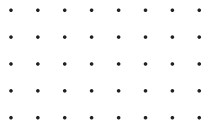
Answer:
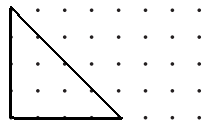
The above triangle has one right angle.
Explanation:
A right-angled triangle is a triangle, that has one of its interior angles equal to 90 degrees or any one angle is a right angle. Therefore, this triangle is also called the right triangle or 90-degree triangle.
Question 3.
Name something that is different about a quadrilateral and a triangle.
Answer: Number of sides.
A quadrilateral has 4 sides and a triangle has 3 sides.
Explanation:
A triangle is a polygon with three edges and three vertices. It is one of the basic shapes in geometry. Triangle is a simple closed curve or polygon which is created by three line-segments.
We can define quadrilateral as a Polygon that has four sides.
Question 4.
Show someone at home how you can test if an angle is a right angle.
Answer:
I Showed to someone that the angle is right angle.
Explanation:
A right angle is an angle with a measurement of 90 degrees. When two lines cross/meet each other at a certain point and if that angle between them resembles the angle formed at the top of the letter T which is at right angles to the vertical line, then we can consider the formed angle is a right angle.
Practice
Question 5.
a. 
Answer:

Explanation:
An addition sentence is a mathematical expression that shows two or more values added together. In the above image we can observe two numbers 23 and 38. First add three and eight in one’s place right side then we got eleven. Keep one in one’s place and then add one to two and three in ten’s place, left side then we got six write six in ten’s place. By adding these two numbers 23 and 38 we got 61.
b. 
Answer:

Explanation:
An addition sentence is a mathematical expression that shows two or more values added together. In the above image we can observe two numbers 56 and 17. First add six and seven in one’s place right side then we got thirteen. Keep three in one’s place and then add one to five and one in ten’s place, left side then we got seven write seven in ten’s place. By adding these two numbers 56 and 17 we got 73.
c. 
Answer:

Explanation:
An addition sentence is a mathematical expression that shows two or more values added together. In the above image we can observe two numbers 26 and 68. First add six and eight in one’s place right side then we got fourteen. Keep four in one’s place and then add one to two and six in ten’s place, left side then we got nine write nine in ten’s place. By adding these two numbers 26 and 68 we got 94.
d. 
Answer:

Explanation:
An addition sentence is a mathematical expression that shows two or more values added together. In the above image we can observe two numbers 36 and 36. First add six and six in one’s place right side then we got twelve. Keep two in one’s place and then add one to three and three in ten’s place, left side then we got seven write seven in ten’s place. By adding these two numbers 36 and 36 we got 72.
Everyday Math Grade 2 Home Link 8.5 Answer Key
3-Dimensional Shapes
Family Note
In this lesson children described and compared different 3-dimensional shapes. The class also created a Shapes Museum using the objects children brought to school. Read the list of shapes below with your child. Together, find examples of the shapes.
Please return this Home Link to school tomorrow.
Work with someone to make a list of things that have these shapes.
Question 1.
cube
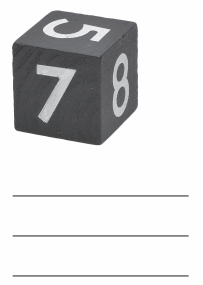
Answer:

Rubik’s cube, dice, some of the cartons, leather stool.
Explanation:
The shape of the above image is cube. Some of the things have these type of shape. There are Rubik’s cube, Dice, Leather stool and some of the cartoons.
Question 2.
Rectangular prism

Answer:
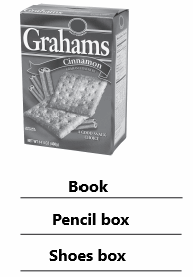
Shoes box, Pencil box, book, mattress.
Explanation:
The shape of the above image is rectangular prism. Some of the things these type of shape. There are book , pencil box, shoe box, Mattress.
Question 3.
Cylinder
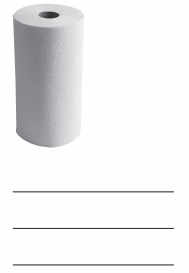
Answer:

Gas cylinder, Tissue roll, Coke tin, Bingo chips can, Battery.
Explanation:
The shape of the above image is Cylinder. Some of the things have these type of shape. There are coke tin, Gas Cylinder, Tissue roll, Bingo chip can, Battery.
Practice
Add.
Question 4.

Answer:

Explanation:
An addition sentence is a mathematical expression that shows two or more values added together. In the above image we can observe two numbers 21 and 24. First add one and four in one’s place right side then we got five. Keep five in one’s place and then add two and two in ten’s place, left side then we got four write four in ten’s place. By adding these two numbers 21 and 24 we got 45.
Question 5.
36 + 14 = __
Answer:
36 + 14 = 50
Explanation:
An addition sentence is a mathematical expression that shows two or more values added together. In the above expression we can observe two numbers 36 and 14. First add six and four in one’s place right side then we got ten. Keep zero in one’s place and then add one to three and one in ten’s place, left side then we got five write five in ten’s place. By adding these two numbers 36 and 14 we got 50.
Question 6.

Answer:

Explanation:
An addition sentence is a mathematical expression that shows two or more values added together. In the above image we can observe two numbers 38 and 56. First add eight and six in one’s place right side then we got fourteen. Keep four in one’s place and then add one to three and five in ten’s place, left side then we got nine write nine in ten’s place. By adding these two numbers 38 and 56 we got 94.
Everyday Math Grade 2 Home Link 8.6 Answer Key
Partitioning Rectangles
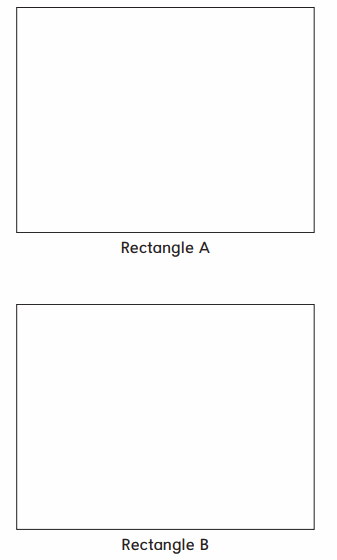
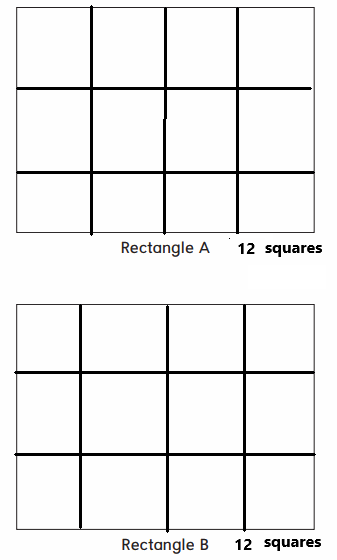
Question 1.
How many squares did you use to cover Rectangle A?
Answer:
To cover Rectangle A we used 12 squares.
Explanation:
In the above image we can observe rectangle A . To cover Rectangle A we used 12 same-size squares. A rectangle is a quadrilateral with four right angles. A rectangle with four sides of equal length is a square.
Question 2.
How many squares did you draw on Rectangle B?
Answer:
To cover Rectangle B we used 12 squares.
Explanation:
In the above image we can observe rectangle B . To cover Rectangle B we used 12 same-size squares. A rectangle is a quadrilateral with four right angles. A rectangle with four sides of equal length is a square.
Everyday Math Grade 2 Home Link 8.7 Answer Key
More Partitioning Rectangles
Family Note
In this lesson children continued their work partitioning rectangles into same-size squares. They used a square block and then a picture of a square to help them determine the size of the squares needed to cover their rectangles. Finally, they partitioned rectangles into given numbers of rows with a specific number of squares in each row. Children are not expected to draw perfect rows of squares.
The goal of the activity below is for them to make rows that are close to the same height and squares that are about the same size.
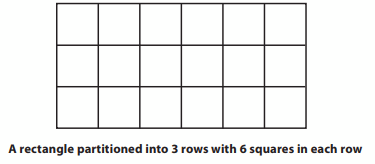
A rectangle partitioned into 3 rows with 6 squares in each row
Please return this Home Link to school tomorrow.
Question 1.
Partition this rectangle into 2 rows with 3 same-size squares in each row.
How many squares cover the rectangle? __
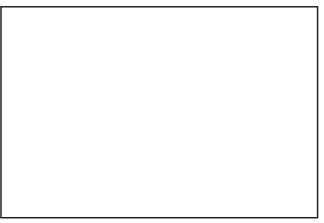
Answer:

6 same-size squares cover the rectangle.
Explanation:
Rectangle is a quadrilateral with four right angles. It can also be defined as an equiangular quadrilateral. A rectangle partitioned into 2 rows with 3 same-size squares in each row. which means 2 x 3 =6. Six same-size squares cover the rectangle.
Practice
Question 2.

Answer:

Explanation:
An addition sentence is a mathematical expression that shows two or more values added together. In the above image we can observe two numbers 18 and 21. First add eight and one in one’s place right side then we got nine. Keep nine in one’s place and then add one and two in ten’s place, left side then we got three write three in ten’s place. By adding these two numbers 18 and 21 we got 39.
Question 3.
46 + 34 = ___
Answer:
46 + 34 = 80
Explanation:
An addition sentence is a mathematical expression that shows two or more values added together. In the above expression we can observe two numbers 46 and 34. First add six and four in one’s place right side then we got ten. Keep zero in one’s place and then add one to four and three in ten’s place, left side then we got eight write eight in ten’s place. By adding these two numbers 46 and 34 we got 80.
Question 4.

Answer:

Explanation:
An addition sentence is a mathematical expression that shows two or more values added together. In the above image we can observe two numbers 59 and 37. First add nine and seven in one’s place right side then we got sixteen. Keep six in one’s place and then add one to five and three in ten’s place, left side then we got nine write nine in ten’s place. By adding these two numbers 59 and 37 we got 96.
Everyday Math Grade 2 Home Link 8.8 Answer Key
Familiar Groups and Arrays
Family Note
In today’s lesson your child solved number stories about equal groups and arrays. Equal groups are groups that all have the same number of objects. Arrays are rectangular arrangements of objects or symbols in rows and columns. Arrays show equal groups because each row in an array has the same number of objects, and each column has the same number of objects. You can find equal groups and arrays in many real-life objects and situations, such as those shown below. Your child can find the total number of objects efficiently by adding the number of objects in each group, row, or column. For example, to find how many dots are in 2 rows of 3 dots each on a die, you could find 3 + 3 = 6. Or you could view the die as having 3 columns of 2 dots each and find 2 + 2 + 2 = 6. To find how many fingers are on 2 hands with 5 fingers each, you could add 5 + 5 = 10.
Please return this Home Link to school tomorrow.
Find the total number of objects in each picture. Then write a number model.
Example:
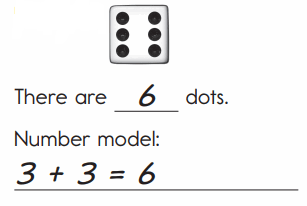
Question 1.
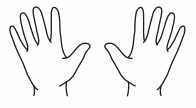
There are __ fingers in all.
Number model:
Answer:
There are 10 fingers in all.
Number model: 5 + 5 = 10; 2 x 5 = 10
Explanation:
Arrays are rectangular arrangements of objects or symbols in rows and columns. Arrays show equal groups because each row in an array has the same number of objects, and each column has the same number of objects. In the above image we can observe two hands with each 5-fingers. The number model for the above image is 5 + 5 = 10; 2 x 5 = 10. There are 10 fingers in all.
Question 2.

There are __ muffin cups.
Number model:
Answer:
There are 12 muffin cups.
Number model: 4 + 4 + 4 = 12; 3 x 4 = 12
Explanation:
Arrays are rectangular arrangements of objects or symbols in rows and columns. Arrays show equal groups because each row in an array has the same number of objects, and each column has the same number of objects. In the above image we can observe muffin cups with 3 rows and 4 columns. In each row we are having 4 muffins cups, so add 3 times of 4 muffin cups. The number model for the above image is 4 + 4 + 4 = 12; 3 x 4 = 12. There are 12 muffin cups.
Question 3.

There are __ shoes in all.
Number model:
Answer:
There are 8 shoes in all.
Number model: 2 + 2 + 2 + 2 = 8; 2 x 4 = 8
Explanation:
Arrays are rectangular arrangements of objects or symbols in rows and columns. Arrays show equal groups because each row in an array has the same number of objects, and each column has the same number of objects. In the above image we can observe shoes pair with 2 rows and 2 columns. The number model for the above image is 2 + 2 + 2 + 2 = 8; 2 x 4 = 8. There are 8 shoes in all.
Everyday Math Grade 2 Home Link 8.9 Answer Key
Drawing Arrays
Family Note
In today’s lesson your child used counters to show equal groups and arrays and then wrote number models to represent the counters. Encourage your child to use pennies or other small objects to help solve these problems.
Please return this Home Link to school tomorrow.
Question 1.
Draw 4 equal groups with 3 in each group.
Number model:
How many in all? __
Answer:

Number model: 3 + 3 + 3 +3 = 12; 4 x 3 = 12
There are 12 objects in all.
Explanation:
In the above image we can observe 4 equal groups with 3 in each group. So add 3 as 4 times. The number model is 3 + 3 + 3 + 3 = 12 it can also be written as 4 x 3 = 12. So there are 12 objects in all.
Question 2.
Draw an array with 5 rows and 3 objects in each row.
Number model:
How many in all? __
Answer:

Number model: 5 + 5 + 5 = 15 ; 3 x 5 = 15
There are 15 objects in all.
Explanation:
In the above image we can observe an array with 5 rows and 3 objects in each row. Add 5 as 3 times. The number model is 5 + 5 + 5 = 15; 3 x 5 = 15. So there are 15 objects in all.
Question 3.
Draw an array with 2 columns and 4 objects in each column.
Number model:
How many in all? __
Answer:

Number model : 2 + 2 + 2 + 2 = 8; 4 x 2 = 8
There are 8 objects in all.
Explanation:
In the above image we can observe an array with 2 columns and 4 objects in each column. Add 2 as 4 times. The number model is 2 + 2 + 2 + 2 = 8; 4 x 2 = 8. So there are 8 objects in all.
Practice
Solve.
Question 4.

Answer:

Explanation:
An addition sentence is a mathematical expression that shows two or more values added together. In the above image we can observe two numbers 23 and 32. First add three and two in one’s place right side then we got five. Keep five in one’s place and then add two and three in ten’s place, left side then we got five write five in ten’s place. By adding these two numbers 23 and 32 we got 55.
Question 5.
63 + 28 = __
Answer:
63 + 28 = 91
Explanation:
An addition sentence is a mathematical expression that shows two or more values added together. In the above expression we can observe two numbers 63 and 28. First add three and eight in one’s place right side then we got eleven. Keep one in one’s place and then add one to six and two in ten’s place, left side then we got nine write nine in ten’s place. By adding these two numbers 63 and 28 we got 91.
Question 6.

Answer:

Explanation:
An addition sentence is a mathematical expression that shows two or more values added together. In the above expression we can observe two numbers 45 and 49. First add five and nine in one’s place right side then we got fourteen. Keep four in one’s place and then add one to four and four in ten’s place, left side then we got nine write nine in ten’s place. By adding these two numbers 45 and 49 we got 94.
Everyday Math Grade 2 Home Link 8.10 Answer Key
Playing Array Concentration
Family Note
Today your child played a game called Array Concentration to practice finding the total number of objects in arrays and writing matching addition number models. In this game children match each array card with the number card that shows the total number of dots in the array. For example, the array card and the number card at the right “match.”
Please return this Home Link to school tomorrow.
Celia is playing Array Concentration. Her matches are shown below. Fill in the numbers on the number cards and write number models for the arrays.
Example:

Question 1.

Answer:

Number model: 4 + 4 + 4 + 4 + 4 = 20; 5 + 5 + 5 + 5 = 20; 4 x 5 = 20; 5 x 4 = 20
Explanation:
Array Concentration is finding the total number of objects in arrays and writing matching addition number models. Match each array card with the number card that shows the total number of dots in the array. In the above image we can observe 4 rows and 5 columns. So write 20 in the number card. The number model for the above image is 4 + 4 + 4 + 4 + 4 = 20; 5 + 5 + 5 + 5 = 20; 4 x 5 = 20; 5 x 4 = 20
Question 2.

Answer:

Number model: 1 +1 = 2; 1 x 2 = 2; 2 x 1 = 2
Explanation:
Array Concentration is finding the total number of objects in arrays and writing matching addition number models. Match each array card with the number card that shows the total number of dots in the array. In the above image we can observe 1 row and 2 columns. So write 2 in the number card. The number model for the above image is 1 +1 = 2; 1 x 2 = 2; 2 x 1 = 2.
Question 3.

Answer:

Number model: 4 + 4 = 8; 2 + 2 + 2 + 2= 8; 2 x 4 = 8; 4 x 2 = 8
Explanation:
Array Concentration is finding the total number of objects in arrays and writing matching addition number models. Match each array card with the number card that shows the total number of dots in the array. In the above image we can observe 2 rows and 4 columns. So write 8 in the number card. The number model for the above image is 4 + 4 = 8; 2 + 2 + 2 + 2= 8; 2 x 4 = 8; 4 x 2 = 8.
Everyday Math Grade 2 Home Link 8.11 Answer Key
Writing a Shape Riddle
Family Note
In this lesson your child learned to recognize a 2-dimensional shape based on specific attributes,
such as the following:
- number of angles
- number of sides
- number of pairs of parallel sides
- number of right angles
Using these attributes of 2-dimensional shapes, ask your child to write a shape riddle. For example: I am a shape that has 3 sides and 3 angles. I have no parallel sides. What shape am I? (The answer is “a triangle.”) Your child can share the riddle with a family member or a friend.
Please return this Home Link to school tomorrow.
Question 1.
Make up your own shape riddle. Give it to someone to solve.
Answer:
I am shape that has 4 sides and 4 angles. I have a pair of parallel sides where length of each side is equal. What shape am I? (The answer is ” a square”).
Explanation:
In geometry, a square is a regular quadrilateral, which means that it has four equal sides and four equal angles. Square has pair of parallel sides and length of each side is equal.